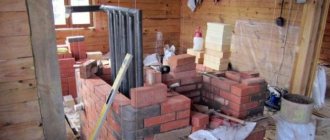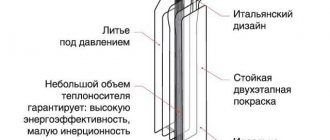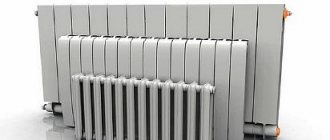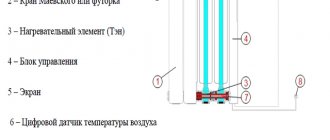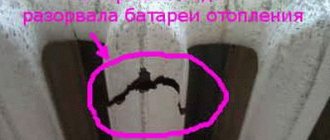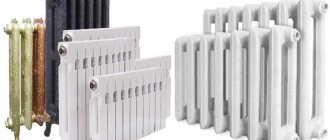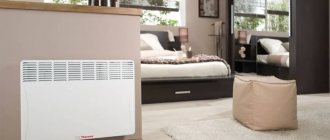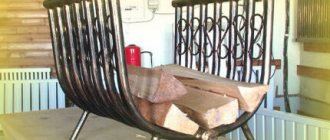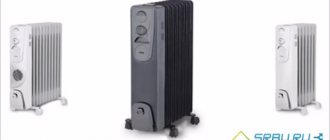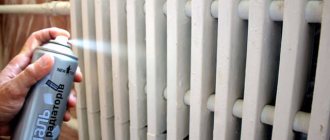Greetings to all my readers!
I have previously written articles about aluminum and bimetallic radiators, as well as convectors for water heating.
In this article I decided to tell you about registers, steel and cast iron radiators.
Almost everyone is familiar with cast iron radiators and registers, but steel radiators are still rare in our market.
Let's start, according to tradition, from simple to complex, and the simplest heating device is a register made of steel pipes.
How many watts of heat does a cast iron battery produce?
The power of a cast iron radiator section is usually about 100-200 W. The operating pressure of a cast iron radiator is the maximum water pressure it can withstand. Typically this value fluctuates around 16 atm. And heat transfer shows how much heat one section of the radiator gives off.
Interesting materials:
What should I give you, my dear performer? What does a person have to do with Rudiments? What is responsible for human memory? What could a skilled person do? What is more important: the inner or outer beauty of a person? What is important in communicating with people? What do cats see that humans don’t? What does a person see if he is blocked on Skype? What does a person blocked in Telegram see? What does a person blocked on WhatsApp see?
Convectors for heating
Convectors are devices in which heat transfer occurs due to convection. The simplest model is a pipe (heat exchanger) with metal plates strung on it. Nowadays, the appearance of such a unit has a lot of variations, which allows it to fit into any modern design without much difficulty. Devices are mounted in different ways. Can be built-in, wall-mounted, floor-mounted.
The structure of a floor convector. Click on photo to enlarge.
Convectors have a number of advantages. First of all, they are reliable; the design of such a unit is quite simple. These heating devices are better than cast iron or steel radiators, as convectors are less bulky. And what is important is that they have a relatively low cost. The disadvantages include a low heat transfer coefficient. For the full operation of such a device, high temperature and speed of water movement are required. In addition, during the operation of appliances, dust is also ingested from the floor, which is then sprayed throughout the room.
Optimal use
The use of industrial radiators is appropriate for heating rooms where the ceiling height reaches 3 m (no more) and the area ranges from 200 sq.m to 500 sq.m.
Places for use of industrial radiators:
- production premises - workshop, pavilion, platforms, covered areas;
- warehouses and storage facilities - for example, a commercial warehouse, granary, etc.;
- car services, garages;
- supermarkets, shopping centers;
- cinemas, palaces of culture, circuses;
- administrative buildings;
- healthcare facilities;
- educational buildings - schools, university buildings, etc.
Calculation of heating in an industrial building:
Registers made of steel pipes: advantages
Heating registers made of steel pipes
A register is several steel pipes (from 3 to 5) welded together.
For the manufacture of registers, steel pipes with a diameter of 40 to 100 mm are used, which are welded together using jumpers.
Most often, people who have welding skills do them themselves.
The heat transfer of such devices is calculated as the total heat transfer of the pipes from which they are welded.
For ceiling heights up to 3 meters, the following figures apply for one meter of pipe:
| Pipe diameter, mm | 76 | 89 | 110 | 133 |
| Heated area, sq. m. | 1,2 | 1,4 | 1,7 | 2,0 |
The main feature of register-based heating systems is the large volume of coolant.
The boiler must cope with this volume of water.
To select a boiler based on coolant volume, there is an approximate ratio of no more than 20 liters per 1 kW of power.
To calculate the volume of the system, you will have to solve a problem from a geometry course on determining the volume of a cylinder.
It is worth saying that a very powerful boiler cannot be used either.
If the coolant flow is insufficient, the boiler will boil, which can lead to an accident and even an explosion.
Homemade devices
Homemade heating register
Very often you can find homemade heating registers on the market. Such devices have been used for a long time. Professional welders make them to order with their own hands. The design of the device is simple, so it does not cause any difficulties. In addition, the quality of such registers is at the highest level.
There is a design called a samovar. This is a separate register that is filled with oil, antifreeze or other antifreeze liquid. A conventional heating element is installed in it, operating from an alternating current network with a voltage of 220 volts. The principle of its operation is similar to an oil radiator.
That is, you install such a device in a room, connect it to the current, and it will heat your room in autonomous mode. No pipework, no heating boilers, no shut-off valves or control devices. The only condition is to accurately assemble a register that will meet the required heat transfer indicator.
Radiators for heating
There are several types of radiators. Each of them has its own characteristics, as well as advantages and disadvantages. The following types of heating devices are used in heating systems.
Cast iron radiator. Click on photo to enlarge.
Cast iron radiators - such devices are made by casting. Thanks to the thickened walls, they can continue heating even after the heated water supply has stopped. They release part of the thermal energy using thermal radiation, which ensures uniform heating of the air in the lower and middle parts of the room. They have a long service life (at least 40 years). Disadvantages include their significant weight and the need for painting.
Steel radiators - these devices are molded welded sheets placed in a decorative steel casing. This gives the radiator an attractive appearance and also increases the heat transfer area. High thermal power is provided by the thin walls of the housing. At the same time, this also contributes to their rapid cooling. The service life of such radiators is 15-20 years. Steel devices are susceptible to corrosion, sensitive to water hammer, and due to the small internal diameter of the flow cavities, they quickly become clogged.
Steel heating radiator. Click on photo to enlarge.
Bimetallic radiators are metal tubes welded together, placed in a ribbed aluminum shell. This design provides heat transfer twice as high as that of cast iron. Since the cross-section of the tubes is small, for efficient operation of the devices, a high speed of coolant movement is required. Such radiators have a fairly high cost and a relatively short service life - about 20 years.
Heating radiator made of aluminum. Click on photo to enlarge.
Aluminum
Aluminum radiators - these devices are produced standard, using a drawing, by casting or shaping from aluminum alloys. They have an attractive appearance and light weight. At the same time, they provide the highest heat transfer compared to other radiators. A serious disadvantage is the property of aluminum to enter into a chemical reaction with the coolant. As a result, hydrogen is released, which must be removed from the system. The service life of such devices is 15 years.
Review of manufacturers
A convector battery, the price of which depends on many factors, can cost in the range from 2 to 20 thousand rubles. The simplest types of electric batteries have a minimal set of functions. Their cost is from 2 thousand rubles. But among the variety of models presented, experts advise choosing electric convectors with TEN or monoblock. Devices from the Electrolux, Polaris, and Ensto brands have proven themselves well.
A gas convector will cost more. Its cost is from 13 thousand rubles. The most famous manufacturers of this type of equipment are Karma, ATON, Gorenje. Reviews about these manufacturers are more positive.
It should also be noted that the cost of the convector depends on the principle of its installation. Floor and wall models will cost much less than built-in equipment.
Types of thermostats used in heating devices based on the convection principle
One of the main elements of any electric convector is a built-in thermostat, which allows you to set the required temperature in the room. The thermostat control can be:
- electronic;
- mechanical.
If the thermal regulator is mechanical, then adjustment is carried out by turning the step switch. Its main advantage is its low cost. Among the disadvantages are:
- inability to set the exact temperature;
- increased consumption of electrical energy.
An electronic thermostat is much more practical in this matter. With its help, you can easily set the required temperature, this device is almost silent, and it uses electricity efficiently. Convectors with this type of thermostat are more expensive, but hardly anyone will dispute their advantages.
What is better for a country house?
For a country house, given the huge number of their positive properties, including the price/quality ratio, standard European-type aluminum radiators are best suited. The owners can choose the composition of the coolant themselves, and also ensure that there are no pressure surges in the system.
The absence of water hammer allows the use of steel panel radiators, which have a fairly low price and good heat transfer parameters.
4.9 / 5 ( 21 voice )
How to improve heat transfer
Operating efficiency depends on the surface of the system. The area of the devices is small, so they are often supplemented with metal plates. The latter are welded vertically, making the pipes artificially ribbed.
Another option involves welding profile elements to the front of the device. They are left hollow: air entering from below will heat up and rise to the top.
The tubular electric generator also helps increase power. It works if the main system has stopped. In this way, constant heating operation is maintained.
In conclusion
The modern market provides the consumer with a lot of types and models of heating devices from which to choose, capable of withstanding the vagaries of central heating. Taking into account the radiator’s resistance to the aggressive environment of water and the pressure inside the system, a successful option is selected that will provide your home with heat for a long time.
The video presented in this article contains useful information on selecting and replacing a radiator.
Did you like the article? Subscribe to our Yandex.Zen channel
Characteristics
Among these indicators lies a secret that can give rise to unflattering reviews of this product and incorrect calculation of the required number of panels.
The fact is that some sellers, either unknowingly or deliberately, confuse square meters with cubic ones. As a result, the consumer buys fewer devices than needed and the house is cold.
An example of such a calculation: the maximum that this heater is capable of, provided there are normal windows, doors and walls, is to heat 18 meters of cubic room space, this means that with a ceiling height of 3 m, the area of the room will be 6 m2. Having made allowance for an opening door, possible drafts, furniture that interferes with the movement of air flow, we get a real figure of about 4.5 m2 per heater.
Thus, for 10 m2 of area two and a half heaters are required. The power of each is 0.4 kW/h. We get 0.4 * 2.5 = 1 kW/h per 10 m2. This is the standard norm for calculating the power of heating systems. You can't cheat physics
To heat a space, thermal energy is required and it does not matter who or what generates it
Panel dimensions - 600 mm X 350 mm X 25 mm.
Electricity consumption - 0.4 kW/h.
